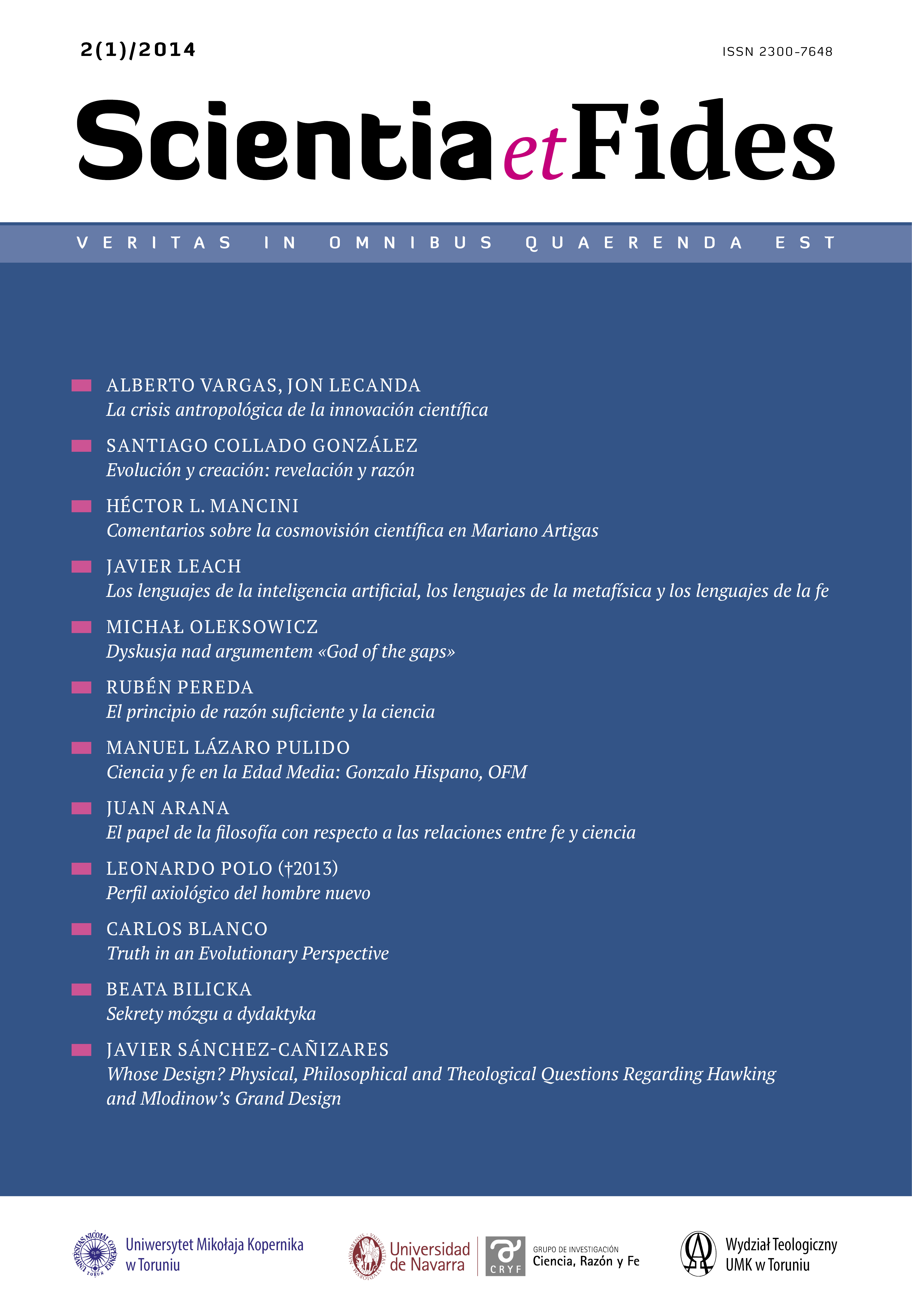Comments on Mariano Artigas’ Scientific Worldview
DOI:
https://doi.org/10.12775/SetF.2014.003Keywords
science and religion, complex systems, self-organization, order, pattern formationAbstract
Some concepts widely used in science are fundamental keys in the work of Mariano Artigas. Words like ‘order’, ‘dynamism’, ‘activity’, ‘chaos’, ‘randomness’, ‘patterns’, ‘structure’, ‘emergence’ or ‘complexity’, which are also used in other fields of thinking, have been used to build M. Artigas’ worldview. From this point of view, he presents the existence of philosophical bridges to overcome the methodological gaps between science and religion. Since the years in which Artigas wrote his work up to now, the scientific meanings of many of these concepts have evolved until reaching today a better level of accuracy, maturity and stability. This article discusses the concept of worldview in M. Artigas related to some notions he used. It is important to remark that the change in the meaning of some words does not affect the general framework introduced by M. Artigas. His understanding of the relations between science and religion still preserves both validity and profit.
References
Agazzi, E. 1974. Temi e problemi di filosofia della fisica. Roma: Abete.
Artigas, M. 1979. Karl Popper. Búsqueda sin término. Madrid: Magisterio Español.
Artigas, M. 1984. Ciencia, razón y fe. Madrid: Ediciones Palabra.
Artigas, M. 1989. Filosofía de la Ciencia Experimental. Pamplona: EUNSA.
Artigas, M. 1992a. La Inteligibilidad de la Naturaleza. Pamplona: EUNSA.
Artigas, M. 1992b. Ciencia y fe: nuevas perspectivas. Pamplona: EUNSA.
Artigas, M. 1992c. “Three levels of interaction between science and philosophy.” In Intelligibility in Science, edited by C. Dilworth, 130–134. Amsterdam: Ed. Rodopi.
Artigas, M. 1992d. El hombre a la luz de la ciencia. Madrid: MC Ed. Palabra.
Artigas, M. 1994. El Desafío de la Racionalidad. Pamplona: EUNSA.
Artigas, M. 1996. “La Mente del Universo”. Lección inaugural leída el 25 de Septiembre de 1996. Universidad de Navarra.
Artigas, M. 1999. La Mente del Universo. Pamplona: EUNSA.
Artigas, M. 2000. The Mind of the Universe: Understanding Science and Religion. Radnor, Penn. USA: Templeton Foundation.
Artigas, M. 2013. “Ciencia y fe: nuevas perspectivas.” Scientia et Fides 1(1): 35–51. doi: http://dx.doi.org/10.12775/SetF.2013.001
Artigas, M., and K. Giberson. 2007. Oracles of Science. New York: Oxford Univ. Press.
Benedicto XVI. 2011. Fe y Ciencia: un diálogo necesario. Santander: Sal Terrae.
Davies, P., and J. Gribbin. 1992. The Matter Myth. London: Penguin Books.
Davies, P., and N.H. Gregersen. 2010. Information and the Nature of Reality. Cambridge: Cambridge Univ. Press.
Hahn, H., O. Neurath, and R. Carnap. 1929. Manifiesto del Círculo de Viena. Viena: Wolf.
Harrison, E. 1987. Darkness at Night: A Riddle of the Universe. Harvard: Harvard University Press.
Juan Pablo II. 1998. Encíclica “Fides et ratio”. Roma: LEV.
Mancini, H. 2007. Preface to New trends and scales in pattern formation. The European Physical Journal Special Topics 146 (July): V-VII. doi: http://dx.doi.org/10.1140/epjst/e2007-00163-2
Martinez, R. 2011. “Ontological Bridges and the Mind of the Universe.” In Science and Faith within Reason, edited by J. Navarro, 11–27. Fanham: Ashgate Pub. Ltd.
Nicolis, G., and C. Nicolis. 2007. Foundations of Complex Systems. Singapore: World Scientific Pub. Co.
Poupard P. 2000. Foreword to The Mind of the Universe: Understanding Science and Religion, by M. Artigas, xi-xiii. Radnor, Penn. USA: Templeton Foundation.
Weinberg, S. 1993. Los tres primeros minutos del Universo. Madrid: Alianza Edit.
Downloads
Published
How to Cite
Issue
Section
License

This work is licensed under a Creative Commons Attribution-NoDerivatives 4.0 International License.
CC BY ND 4.0. The Creator/Contributor is the Licensor, who grants the Licensee a non-exclusive license to use the Work on the fields indicated in the License Agreement.
- The Licensor grants the Licensee a non-exclusive license to use the Work/related rights item specified in § 1 within the following fields: a) recording of Work/related rights item; b) reproduction (multiplication) of Work/related rights item in print and digital technology (e-book, audiobook); c) placing the copies of the multiplied Work/related rights item on the market; d) entering the Work/related rights item to computer memory; e) distribution of the work in electronic version in the open access form on the basis of Creative Commons license (CC BY-ND 3.0) via the digital platform of the Nicolaus Copernicus University Press and file repository of the Nicolaus Copernicus University.
- Usage of the recorded Work by the Licensee within the above fields is not restricted by time, numbers or territory.
- The Licensor grants the license for the Work/related rights item to the Licensee free of charge and for an unspecified period of time.
FULL TEXT License Agreement
Stats
Number of views and downloads: 387
Number of citations: 3



